How To Install A Turbo On A Honda Civic
Full-Race 2006-2011 eighth gen Honda Civic Si EFR Turbo Kit Installation
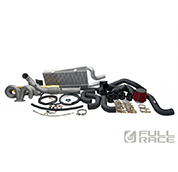
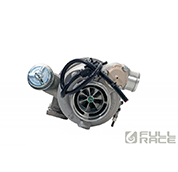
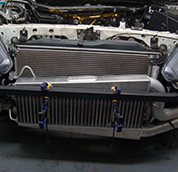
Installing a turbo kit requires a basic agreement of cars and turbochargers, a rubber working environment and proper tools. Experience with previous turbo vehicles or Hondas helps only is non mandatory. A turbo kit install is not a good idea to rush into blind – fix mentally by spending some time to learn about your turbo and read the EFR training manual. Get a good selection of tools and equipment to tackle the chore. If you're a noob and scared of messing something upward, don't stress – Take information technology slow and do some inquiry, anybody starts where y'all are. Start by reading: Maximum Heave past Corky Bong and Street Turbocharging by Marker Warner. We strongly recommend reading the BorgWarner EFR training manual to empathise the applied science and features found on the EFR turbos. There are many ways to do a turbo install, this article presents a few different options and some "best-practices" and tips specific to this engine and chassis combination. If this commodity helps y'all, please share it with others!
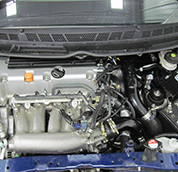
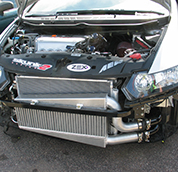
Regardless of experience level, properly turbocharging a 8th gen Honda Civic Si can be a rewarding and successful project. These K20 engines are unique with their high functioning iVTEC cylinder heads and a strong ii.0L bottom stop able to reliably generate outstanding power – at low boost on pump gas, using a condom and conservative tune (10-12psi recommended for stock internal K24). I big reward to using an EFR turbo is they integrate many aspects of turbocharging controls into the turbo – allowing you to start the install by "bench-assembling" the EFR turbocharger and reduce vehicle downtime.
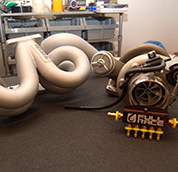
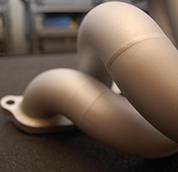
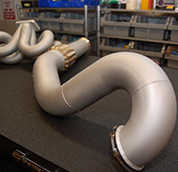
Total-Race's Thou-series VTEC turbo kits are based upon the simple principle that high RPM and high VE (volumetric efficiency) engines work all-time with no restriction on the exhaust side (lowest backpressure possible). Our legendary tubular turbo manifolds, downpipes and exhaust take gained enormous popularity as a outcome of proven HP gains for many enthusiasts. Each and every frazzle manifold is handmade in-firm at Full-Race. We utilise loftier form stainless steel and robotically TIG weld the runners, these are the highest quality and strength welds in the entire aftermarket manufacture – with non one single failure since we started this process in 2003. As with all of our VTEC turbo manifolds, this design uses long runners and our trademark low-angle merge collectors for maximum flow and minimal pressure driblet. The parts you lot will need in addition to the turbo kit are:
- Full-Race 3? Exhaust
- Clutch: CC stage four recommended or Twin-disc for built motors, competitive drag racing and higher boost levels ($1100 includes flywheel)
- Hondata Flashpro: Mandatory for tuning this ECU
- Hondata 4 Bar MAP Sensor:
- OBD1 IAT: You will exist eliminating the MAF sensor with this kit, and Full-Race welds in an OB1 IAT hurl in the charge pipes, purchase one and a pigtail at Honda or clip one off a ninety'due south Honda (on the intake manifold!) at a junkyard (free-$40)
- Fuel Pump: Walbro 255lph is an onetime and reliable favorite, the Deatsch Werks 265c is a perfect replacement for stock and Deatsch 320lph is a good choice if you lot want to build the motor afterward down the route. The 320 will fit without cutting but is a tighter squeeze than the 265c. The DW 320 is a turbine design, so quieter than the Walbro 255 and 265c
- Injectors: 1000cc+! Fuel Injector Clinic, DeatschWerks and Injector Dynamics are all crawly
- Fuel Force per unit area Regulator: 06+ Hondas have returnless fuel systems. Y'all may want to upgrade to an external FPR and fuel rail with return line if targetting more 430whp
- 2 Stride Colder Iridium Spark Plugs (oestrus range 9): NGK BKR9EIX, aka 2669. A gap of .022 is recommended
- Hasport motor mounts and Full_Race Traction Balls have a huge comeback to adding traction and stopping wheelhop (wheel hop is bad for your transmission!)
- Optional components such as Air/Fuel or Boost Gauges , vacuum block of form Full-Race Shift Knob! Email sales@full-race.com and nosotros can go you lot a bundle pricing discount.
Once you know the fuel used and heave level/HP target, adjacent select who your tuner will be. We recommend whenever possible going to a local reputable experienced tuner who knows Hondata software and familiar with turbocharged Chiliad-Series Hondas. It can be helpful to have someone nearby experienced to lend a manus or look over the auto should y'all take any questions. There are also many fantabulous E-tuning options to choose from, where the tuner can email you lot calibration tweaks based on your logs. We're happy to brand a recommendation for you depending on your location and setup.
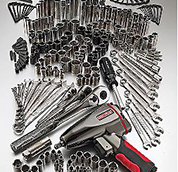
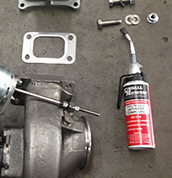
Tools required are about the same as doing a clutch install (plus a few extras). A good option of metric combination wrenches, 3/8? and 1/2? ratchets with deep and shallow sockets with swivels/extensions, an impact gun (air or electric), a small cutting device (pneumatic jigsaw or electrical four.five? angle grinder), an adjustable crescent wrench, and a 3/8? NPT tap. In addition, loftier-temp anti-seize should be carefully practical to all stainless steel threads and clamping surfaces ; Frazzle manifold bolts/studs/basics, vband surfaces/nuts, wastegate actuator lock basics and bracket screws, etc they should all have anti-seize!! Also try to have a friend or actress transportation available if y'all need to run out for something.
Intro: Aftermarket turbos require you to "clock" the center section and bearing housing to adapt the awarding. Prepping your turbo for installation ahead of time saves hours on the install process. In the instance of the EFR nosotros besides have a wastegate, BOV, coolant/oil feed and drain fittings and boost control all integrated into the turbo. This reduces the corporeality of parts needed for the install and means we must clock it into position for proper fitment, before taking the car apart. Have your time, starting this step a few nights before you programme to do the install is a proficient idea, since it will set the stage for everything else to come up.
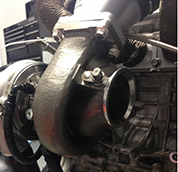
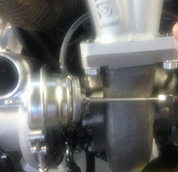
Step 1a: Clock turbo, install fittings:
Beginning accept off the actuator bracket that comes on the turbo, forth with the WG canister, the bracket sent with the kit volition need to be utilized. Adjacent, loosen the Compressor 5-Band and the other bolts with swivel plates slightly so yous can adjust the turbo'due south orientation. Next, report these pictures and try to replicate everything as closely as possible. Reference the coolant fitting locations (in on the bottom and out on the opposite side top) using the supplied aluminum -6AN fittings and shell washers. Make sure to use high temp anti-seize on all turbo hardware and the special loftier temp lock-washers included should remain as pairs – not be separated or lost. They will keep tension on the turbo hardware and make sure the gasket stays leak free, never allowing vibrations or heat cycling to loosen from the manifold.
One time the turbo is clocked, Mountain wastegate and bracket, using anti-seize for all threads – the Wastegate actuator arm must sit comfortably without misalignment or bounden. Once its centered in the 'happy place' the actuator arm position dictates the center-section-begetting-housing's last resting position. We also recommend to cover the WG actuator canister with the cocky adhesive gilt foil to protect it from the turbine housings radiant rut.
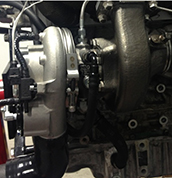
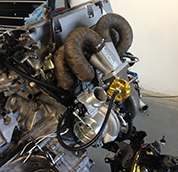
Step 1b: Attach clocked turbo to Manifold:
Bolt the clocked and oriented turbo to the manifold using the supplied hardware and lockwashers + T3 gasket and so information technology looks exactly like the in a higher place photos – pay special attention to the WG bracket orientation on the begetting housing, oil feed fitting and the coolant fitting positions in relation to each other . Double check that all fasteners and mating surfaces have anti-seize and are fully tightened, the coolant fittings have crush washers and that only the steel bleed fitting's 3/8? NPT tapered threads (at the turbo'south oil bleed port) has Teflon thread sealant – Do not utilise thread sealant on the compression fittings such as -6AN aluminum coolant or -10AN aluminum hose ends! Nevertheless it is OK to lightly use anti-seize to the aluminum fittings. Adjacent, tighten the oil feed line's 90 degree plumbing equipment to the turbo's -4AN feed and route the hose toward the correct hand side of the engine. When tightening this compression fitting be sure it is tight and will not leak, but also that the stainless braided hose is non touching the manifold's runners, collector, flange or turbine housing. Have care that the turbine housing'due south clamps are located properly in the locked position and fully tightened. Don't forget the gasket!


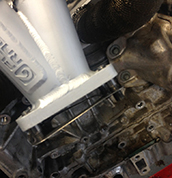
Step 1c: Preparing Vacuum Hoses for BOV and boost control:
Insert the supplied 3/xvi? vacuum hose on the BOV, and use a zip tie to keep it in identify. Attach the Boost command solenoid's long vacuum hose to the wastegate'south upper nipple, and slide the clamp in place. The only fastener y'all will need to arrange afterward is the Compressor Housings' vband nut (you can leave this just loose plenty to rotate the housing past hand, but tight enough that it isn't rattling or falling off (we volition fully tighten it in the car afterwards, along with the downpipe's vband clamp). Lastly, we recommend using Hondata's Heave-By-Gear (BBG) and yous tin can plug the heave command solenoid in at present. If no boost control is connected to the solenoid you will simply be running low boost all the time, which is perfectly condom for starting with and troubleshooting.
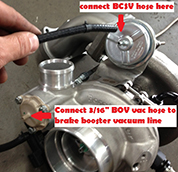
Footstep 1d: Install WG with bracket, setting the EFR wastegate preload:
The EFR 7064 or EFR 7670 turbos come up standard with BorgWarner's "b2 bent bracket" and mid boost wastegate bound (ideal for viii-12psi boost levels). For whatever loftier horsepower builds, the large EFR8374 and EFR9180 come up standard with a "b2 straight bracket" and mid boost wastegate leap – this fits perfectly in a 9th gen chassis. Installing the 7064 or 7670 turbo into a Borough Si (like we are doing here) requires swapping the wastegate bracket to the b2 straight subclass (from the 8374/9180) OR Full-Race's first bracket (supplied with the kit, shown hither). This Offset bracket is the same one used on our 06-11 Borough Si FG/FA kits and requires a 6mm ten 1.0mm die for adding boosted threads to the mid boost jump – Trim wg arm if start subclass is used as shown in the photo. For WG preload setting, delight meet the sheet that comes with your turbo, and as well read the training manual mentioned in a higher place. In this instance information technology'due south a 100% stock engine only for daily driving on pump gas. This car will non see race gas or higher heave, so we are using a base low boost setting three-4mm preload (iv turns of the rear nut, locked in place with the front nut) and not connecting the boost controller. Optionally you can utilise a multifariousness of different aftermarket EFR wastegates to achieve youre desired range of boost targets (many of which are direct plug-and-play no demand to add threads with the die). E-mail tech@full-race.com with questions on your application, we will be happy to make EFR wastegate recommendations based on the awarding, fuel used and target boost level.
Afterwards completing this step, y'all can slip the three/8? coolant hose over the -6AN 90degree hose finish barbs and utilise the hose clamps to fasten them securely (use clamps, do not rely just on the pushlock barbs despite what the hose mfg's claim!). Now yous're almost ready to take the machine apart and offset attaching the turbo kit to the engine.
Stride 2 (or optionally footstep 3): Drop Subframe, remove all-motor intake, header and frazzle:
In order to admission the rear and bottom of the engine it volition require similar work to doing a clutch install and also removing the intake/header/exhaust – Too – unplug and remove all four fuel injectors at this betoken.
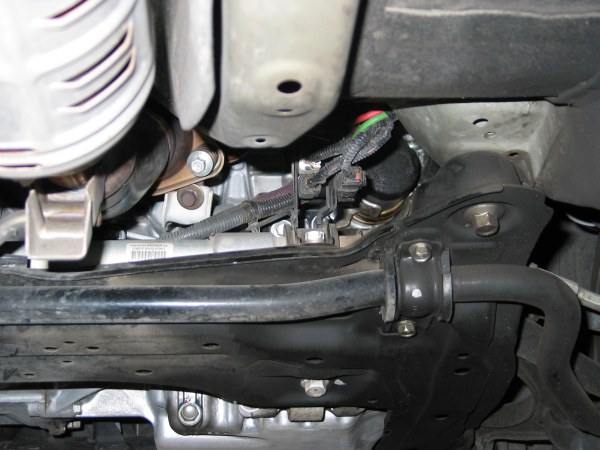
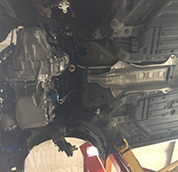
A very short and simplified version of how to unbolt the front subframe from the frame rails and brand room to work: First, safely go the car in the air, remove front wheels, lock the steering cycle in identify, disconnect and remove the battery. Adjacent, unbolt universal from steering rack splines (get out plastic alignment tab on the steering rack), unplug electrical powersteering rack, unbolt lower control arms to carve up from their ball joints (but non separating LCA from subframe), pull axles/intermediate shaft, then lastly using a floor jack or a friend, unbolt and lower the subframe. Having a second ready of hands can help brand this get quickly. (Your offset time is ever the hardest, it gets easier from in that location!). Unbolt and remove exhaust/downpipe, only save 02 sensors – you lot will demand to install them on the downpipe later. Remove air cleaner box/intake and you tin either exit the safety snorkel thing in the fender or you lot tin pull the fender to remove it. Examine all motor mounts for any cracks or signs of weakness/sagging. Examine LCA compliance bushings for harm – especially if the car is extremely depression. BTW: now is a very skilful fourth dimension to upgrade to an aftermarket 06-11 Borough Si clutch and flywheel. If doing the clutch install at the aforementioned fourth dimension as the turbo kit install, it may exist easier — but not necessary — to driblet the engine to separate the transmission and tap the oil pan + install the manifold, turbo, downpipe, wastegate, and dump tube associates. This engine is very like shooting fish in a barrel to driblet!
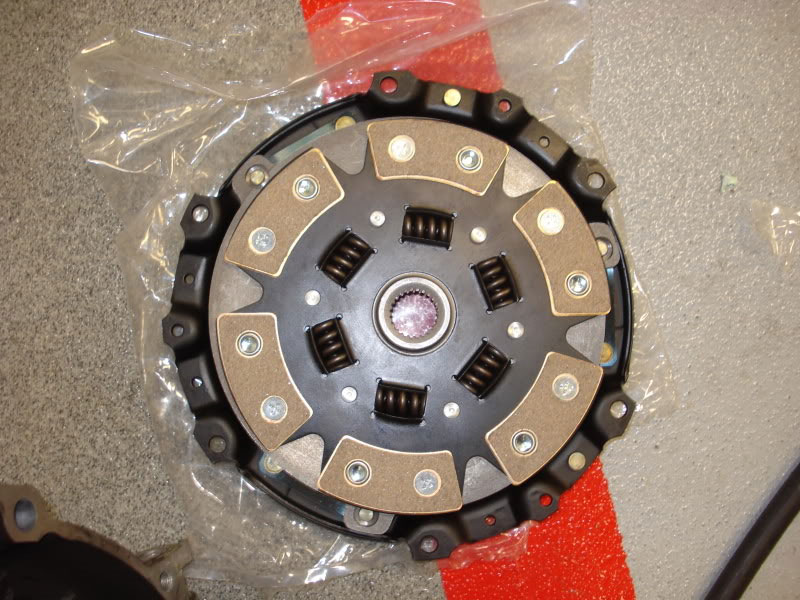
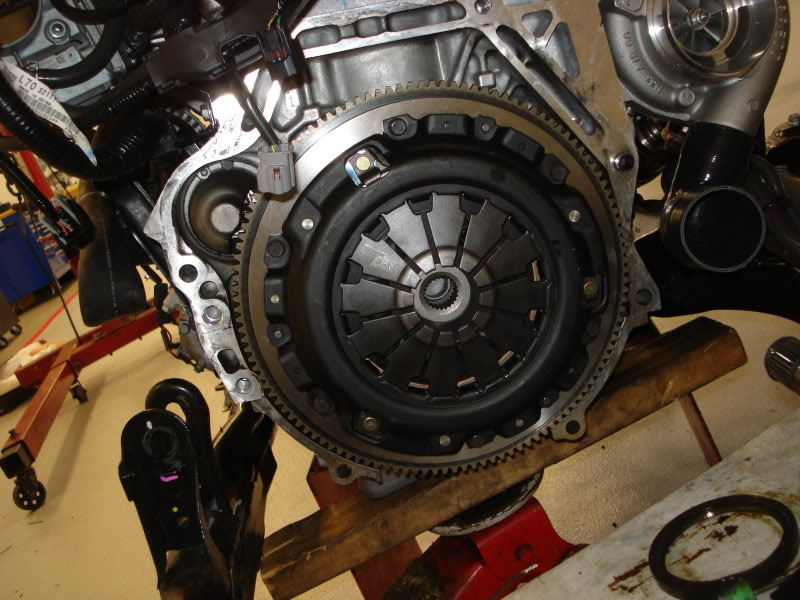
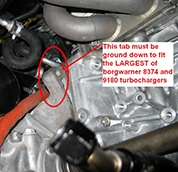
Now is also a good time to trim the extra ear of the transmission, particularly if you are running a big-boy EFR8374 or EFR9180. If everything looks good, and the clutch is installed, its time to practise some existent work!!
Footstep iii (or optionally step two): Prep For Oil Bleed :
This can optionally be washed equally stride two if you have a second oil pan to prep, helping reduce reanimation. You must unbolt the oil pan and remove it from the motor, to be sure all metal shavings are cleared before reinstalling with skillful sealant (hondabond!). Basically nosotros want to drill/tap above the OEM drain plug, where the aluminum is thickest. Some people prefer to TIG weld this plumbing equipment, but most people prefer drilling/tapping to three/8? NPT. You lot can find this tap at any local hardware shop, home depot, etc just go slow and don't tap information technology too deep. Remove the fitting and check. If you mess it up, its piece of cake to get a bigger one /2? NPT tap and start over.

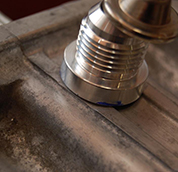
Afterward finishing this stride, clean it. Twice. NO Metallic CHIPS!!! Apply hondabond. Reinstall.

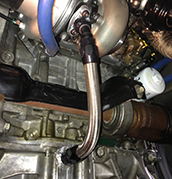
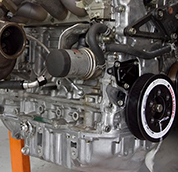
Footstep 4: Oil Feed
This is a elementary one: Remove oil pressure sending unit, install BSPT->NPT adaptor, 1/eight? Tee, and then -4AN plumbing equipment and Oil pressure sending unit of measurement on the oil feed tee. Use Teflon thread sealant on all 1/eight? tapered threads here. Make sure information technology is plenty tight and wont leak, just don't go crazy overtightening like mad.
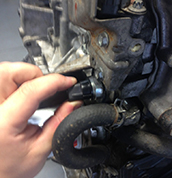
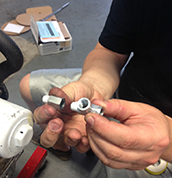

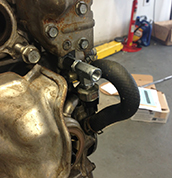
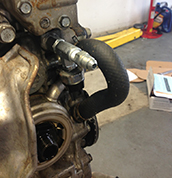
At present is a good time to test fit everything and make sure you have the turbo clocked in the correct orientation and WG subclass plumbing fixtures within the firewall's space constraints.
Footstep 5: Trim steering rack tab to protect EPAS (electrical power steering) harness from the oestrus:
When converting this car from NA to turbo, we have to make sure in that location are no wires near the hot turbo or downpipe. Offset with the Ability steering harness tab, in order to clear our large high flowing 3? downpipe, the steering rack strap's mount must be trimmed for clearance.
Step 6: Wiring and Brake line oestrus Protection:
Now is an ideal time to gold foil your wiring harness, power steering harness, and anything that is up against the firewall past wrapping with the self-adhesive gold foil. Take your time here and brand sure everything is covered to your liking. Spending an actress hr on this step will exist worth it long-term. We recommend to use a paper cutter and cut the foil into i? strips, so wrapping that like a ribbon effectually the harness. Most importantly, wrap the wires which run along the firewall AND the powersteering harness at the RHS frame rail since they would be close to the turbine housing and downpipe. If your harness or restriction lines are filthy dirty, it may exist benign to wipe everything down with rubbing alcohol to ensure the foil sticks.
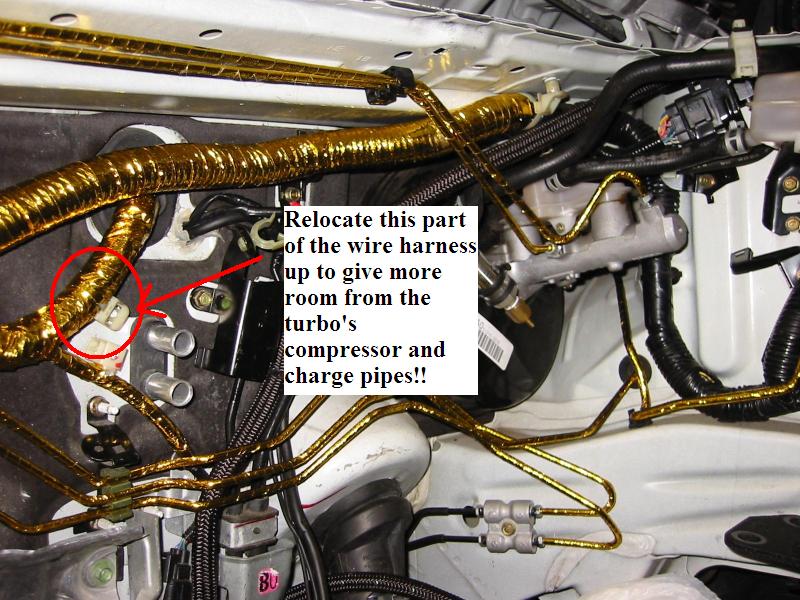

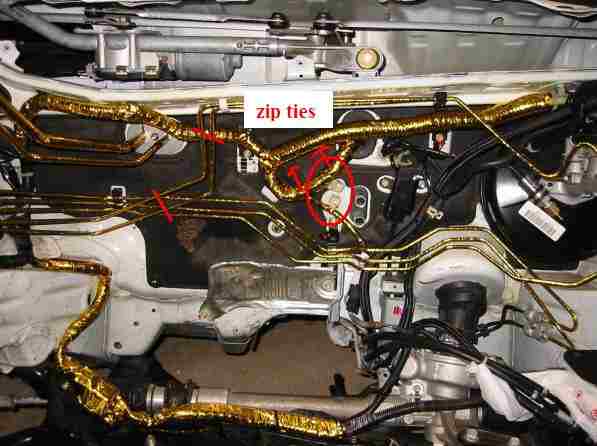
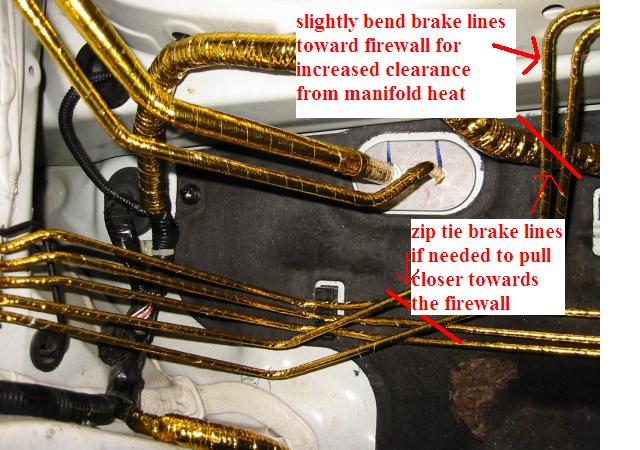
We recommend to protect the electric PS rack's harness along the firewall, to make certain information technology does not become near downpipe heat. Information technology's the black harness on the left, this guy forgot to wrap it:
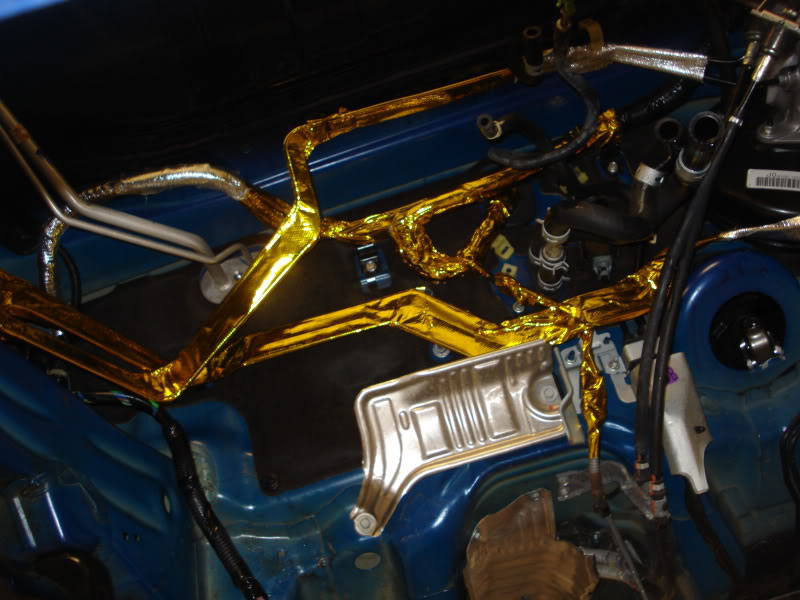

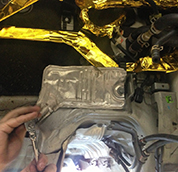
Lastly, information technology'south also a practiced idea to gold foil the 90* silicone elbow that will come up off the compressor housing and the WG actuator canister as shown previously.
Pace seven: Install the Turbo and Manifold on engine:
If the exam fit went well, all the wires are protected and the oil lines prepped – the fun part finally arrives: putting the turbo/manifold on the engine for skilful. The trick to this is the bottom left commodities can be a pain. You either take to start with this one first OR you can relocate a stud to the bottom left and make things easier. Below is a pic of moving the stud (using ii basics) and where we relocated it.

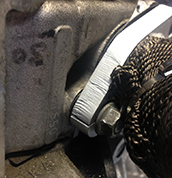
Re-employ the OEM multi layer steel exhaust manifold gasket, just brand sure it'southward in good shape (they usually are). Apply high-temp anti-seize to the cyl caput'due south threads. Bolt the turbo to the manifold, making sure to utilise the supplied gasket, studs and high temp washer. Place the manifold and turbo associates onto the engine, and tighten into identify. Examination fit the oil feed line to your feed fitting and likewise check oil return angle (should be vertical).
Footstep 8: Bolt upwards Intercooler Mountain Axle, trim extra sheetmetal under frame rail at accuse piping area
Now it'southward fourth dimension for you to get the intercooler installed. Luckily this isn't too hard. Commencement, Unplug fog lights, unclip and remove bumper cover, unbolt bumper beam crash bar, and remove plastic shroud on drivers side in front end of radiator/ac condenser. Before installing the FMIC, y'all must rotate the ambient air temp sensor vertically and retighten – otherwise it does non fit betwixt the intercooler and AC condenser.
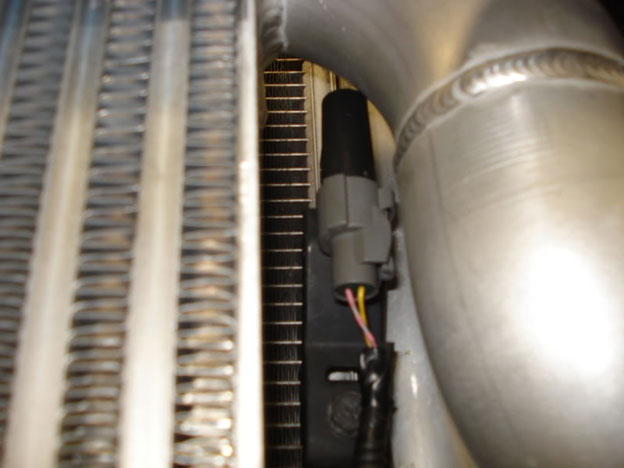
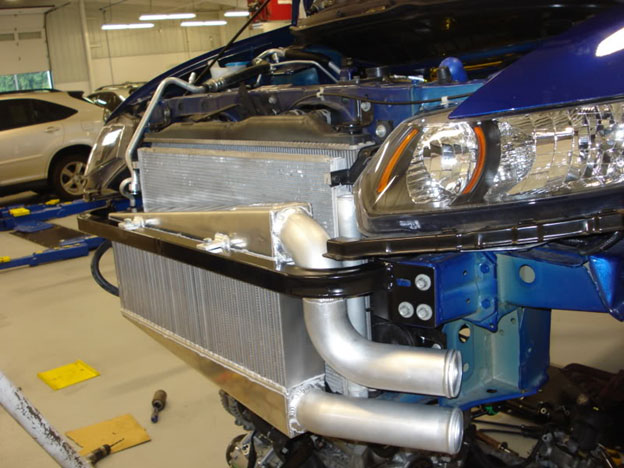
Once you are washed with this, bolt the Full-Race IC mounting beam in place of the stock beam but re-use the stock hardware. Centre the intercooler between the headlights, clamped in identify making certain at that place is a clearance effectually all edges of the intercooler and that there'south nada touching or rubbing the IC. Make sure to quadruple check with a tape measure that yous locate the intercooler directly centered between the headlights before drilling the holes with a 21/64? scrap for the mounting hardware. Here is how we made certain the intercooler was aligned before drilling the first pigsty:
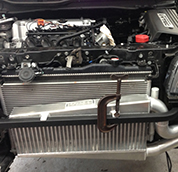
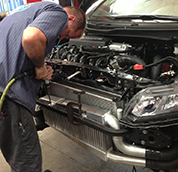
Afterwards the outset hole is drilled, tighten the supplied nut/washer/commodities, then triple check measurements/clearance and drill the other side.
Accuse Pipe Clearance
After the FMIC is mounted, you're going to trim and bend some not-structural sheet metal by the driver's side fenderliner in order to fit the accuse pipes through. Accept a look at the pics below to get a good idea of how much you demand to cut. Annotation that trimming this is not affecting your car in any negative way.

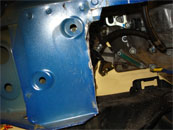
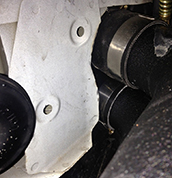
Subsequently you're done with you are fix to fit the charge pipes. This can be challenging but is not besides hard once y'all accept everything lined up. The pipe is routed similar this to give you the quickest spool possible, and so its well worth the effort to get this right. Its easiest to start from the TB leading to the IC's lower endtank and followed by the piping to the turbo's compressor 90 degree silicone elbow. The TB and cold side charge pipes are the easiest, only connect all the pipes together starting from the bottom endtank to the throttle body. Put T-Bolt clamps loosely around the silicone couplers, then wiggle everything together (tip: using some soapy h2o in a spray canteen tin can help them move into identify!).
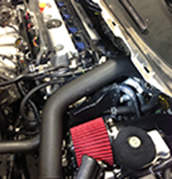

The hotside piping is routed from the compressor 90 deg coupler outlet. This outlet should exist positioned parallel to the firewall, pointing directly at the driver side fender. The charge pipe volition go over the transmission, then downwardly around the front-left-bike to the IC's superlative endtank. It's a lilliputian fussy to get everything gear up simply proper angling of the coupler on the turbo and patience threading the pipage by all the lines in the back of the engine bay goes a long manner!
Now that yous've washed this, it is time to plug in your IAT sensor. Split open the shield around the MAF sensor's wiring and follow this DIY from Hondata to splice in the OBD1 IAT Sensor. http://www.hondata.com/help/flashpro/index.html?afm_removal.ht Then place the sensor into the bung that's welded on the Total-Race TB charge pipes.
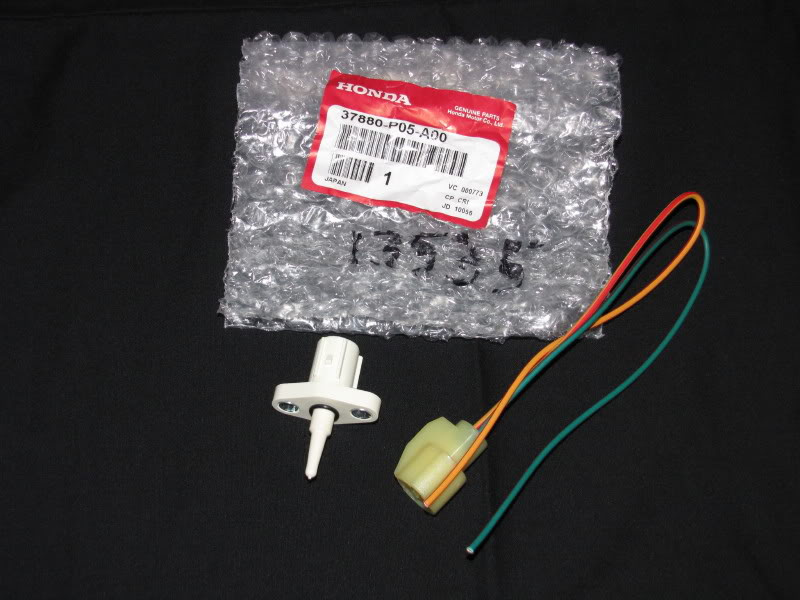
Go over all piping and brand sure the pipes are not rubbing on anything: hotside pipes/intake tube should not touch any of the wiring harness/brackets/hoses, nowhere on the manual or shift linkage, and not on the frame rails/subframe. Coldside pipes should not hit the clutch slave cylinder hardlines or clip subclass. The aluminum charge pipes should not rub each other, if anything is touching, readjust then there is a small gap. It'southward okay to have slight misalignment in the couplers, just make certain the beadroll is firmly seated behind the clamp and everything is resting comfortably. You may need to fold or trim the abrupt sheetmetal corner of radiator support (effort a hammer or crescent wrench) to make certain there is no rubbing on the pipes. If everything checks out, tighten the clamps using 7/16? deep socket (or 11mm deep socket)
Install Intake tube
Next, in order to install the iii.5? Intake, coupler/clamp and air filter you will need to create some infinite. The shifter cables go nether the intake tube, and the heater hoses become above. We add a simple zip-tie to keep the wire harness secure and moved abroad from the intake piping. Nosotros too loosen the heater hose clamp slightly, rotate it counter-clockwise then tighten the clamp, just to keep it away from the intake tube.
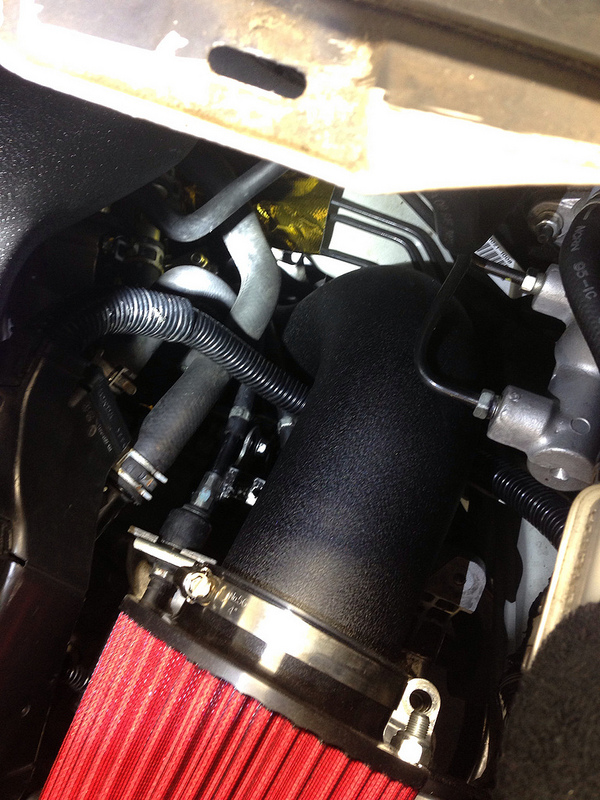
Y'all may also gently move the brake lines to massage actress space – gently push against the hardlines with your hands on a rag and it will bend in easily – don't go crazy, it just takes a trivial bit of push. Y'all can likewise install the downpipe and o2 sensors at this time. Do not fully tighten the downpipe vband, it will demand terminal adjustment once the subframe is in identify.
Stride 10: Going through the plumbing:
A properly primed and leak-free oil feed and drain line are crucial to proper turbocharger health and performance – Triple bank check your oil fittings at this point since we want the turbo to immediately receive oil force per unit area upon engine startup. Check -4AN ninety degree oil feed to engine side – make sure information technology is tightened and volition non leak and likewise tightened at turbo side without rubbing the stainless hose on annihilation. Measure the oil drain hose, cutting information technology to length, attach it to the fittings, and use hose clamps to tighten.
TB coolant hoses – these hoses are just used to go on the TB warm in freezing cold conditions. For a performance application (particularly a turbo one) we don't want a heated TB – so we will repurpose these ports for the turbo. Interesting Fact: Coolant is used just for keeping oestrus out of the turbo'due south bearings *afterward the engine is turned off*. When the engine is running, the oil is doing all of the cooling, the coolant has no purpose. Disconnect and adhere the upper turbo fitting (coolant return) to upper TB coolant hose port at cylinder caput using iii/8? hose, attach the lower turbo fitting (coolant feed) to lower TB coolant hose port at cyl head.
At this point the entire turbo kit is installed, and there should be no extra parts. Give everything a double and triple check then get gear up – its time put the subframe/steering rack/suspension back on the motorcar.
STEP 11: REINSTALL SUBFRAME/AXLES + INTERMEDIATE SHAFT/ bumper encompass
Be careful not to scratch the headlights or fenders and make sure everything fits comfortably over the intercooler and piping without metallic-on-metal contact or rubbing. Readjust the downpipe to brand it fit perfectly with the engine mounted in place. Install 3? Frazzle at this time. Reinstall the O2 sensors and tighten the Five-Band clamp. **We recommend that yous glaze the V-Band clamp's threads and inner flange groove with high temp anti seize — this helps information technology tighten straight and the threads will last a long time!**
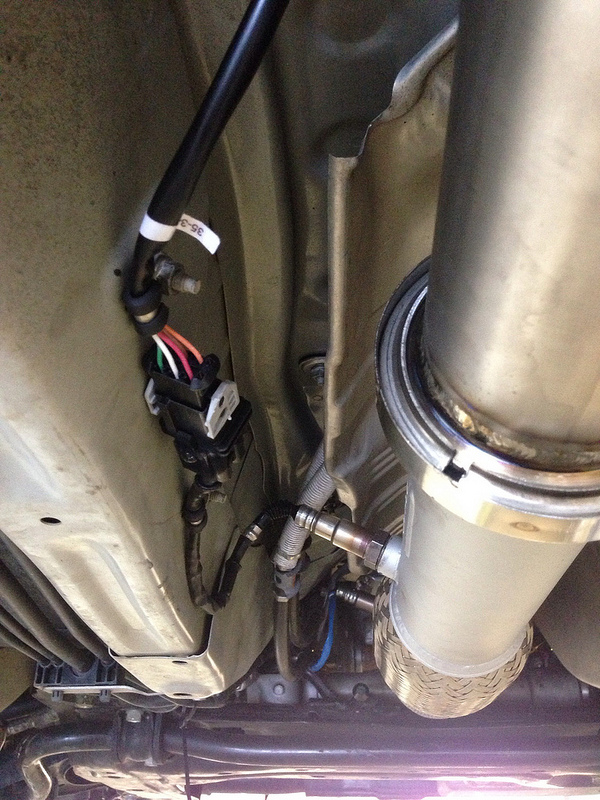
At present you lot tin fully tighten downpipe on the turbo, One time it'south on and tight, go alee and put everything back on the machine. If you have an '09-eleven, you lot will take to remove commuter'southward side foglight from bumper cover to fit the intercooler. You tin merely accept out the lights and get out the lenses in, or go for some of the block off plates that are found on non-Si civics.
Footstep 12: Battery
We previously removed the battery tray to fit the charge piping. At present, cut battery tray to relieve ECU mountain tab, and reinstall to hold ECU securely. You have a few options for how to handle the battery:
- Rotate bombardment and fabricate tray (Easiest, most common)
- Get to a lightweight mini battery (just don't go out it sitting connected for weeks at a time without starting the car)
- Movement battery to the torso: a battery mounted betwixt the rear wheels improves vehicle handling (a good play a joke on to doing this is to get a bmw's battery cable from a junkyard, almost a perfect fit)

Step 13: Final Details: Install Hondata Flashpro, Fuel Injectors, Fuel Pump, Map Sensor, IAT/MAF and any Gauges:
Now is a proficient time to expect everything over and brand sure you are 100% satisfied with the connections and plumbing. There should be no loose bolts, no leaks and nothing rubbing. Fill the engine with oil (synthetic!!) and with your injectors unplugged – and then the engine tin not burn down – turn the key to the start postion and let the engine plough over and build oil pressure inside the turbo. After fifteen-20 seconds of cranking, check the oil level in the oil pan and get set up to finish the fuel arrangement and commencement the engine.
The Hondata FlashPro is a crucial component for proper turbocharging equally it connects from your laptop'south USB port to your vehicles diagnostic port to provide real time programming plus a variety of scale options and extensive datalogging capabilities. It also gives us full control over the new injectors and boost tables.
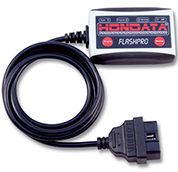
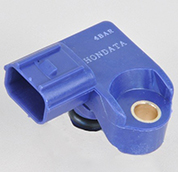
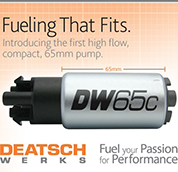
- Install Flashpro: http://www.hondata.com/flashpro_2012si_acura_ilx.html
- Swap to the Hondata Map sensor <plug and play>
- Install the Fuel Pump: Here is the link for a DIY on how to install your upgraded fuel pump. http://world wide web.8thcivic.com/forums/diy-honda-civic-engine/253450-diy-walbro-fuel-pump-new-improved.html
- Install Fuel Injectors – You don't have to de-pivot or wire anything if you lot have the plug and play clips. Subsequently you unplug the injectors, information technology is a good fourth dimension to pre-lube the turbo organization! Fill the motor with expert synthetic oil and crank it over to go oil pressure in the turbo and feed line.
- Gap new iridium spark plugs, rut range #9 NGK BKR9EIX (aka stock number 2669) to .0022?
- Install breather filter, or hose/grab tin off valve cover
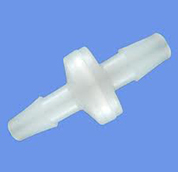
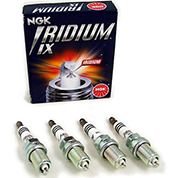
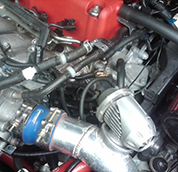
-Install 1/4? check valve in EVAP line to avoid losing any boost to the gas tank. Arrow must betoken toward the hose going to the engine.
Source: https://www.full-race.com/articles/2006-2011-honda-civic-si-turbo-kit-install-guide
Posted by: abarcaalts1960.blogspot.com


0 Response to "How To Install A Turbo On A Honda Civic"
Post a Comment